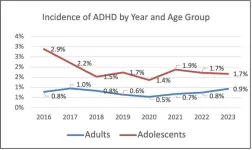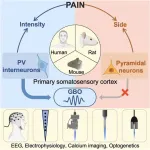(Press-News.org) The cause of rare diseases is increasingly being detected through genome sequencing, which involves reading the entire human DNA by first breaking it into small pieces—short reads. Christian Gilissen, Lisenka Vissers, and colleagues found that a new technique using long reads is even more effective at detecting complex causes. They report that eighty to ninety percent of cases were detectable, as stated in the American Journal of Human Genetics.
Rare diseases are typically due to genetic causes. These causes are more and more often identified using genome sequencing techniques. Genome sequencing examines the entire genome of an individual, which consists of over 3 billion building blocks of DNA.
Missed Information
To read a genome, DNA is first cut into small pieces of about 300 letters, known as short reads. These pieces are read and then reassembled until the complete genome is mapped. “This method has allowed us to identify the cause of quite a few rare diseases,” says Christian Gilissen, Professor of Genome Bioinformatics at Radboudumc. However, the short reads technique also has its drawbacks. The huge collection of small genetic pieces cannot always be reassembled in the exact right places. This is especially true for very long repetitive sections of DNA (repeats) and for pieces of DNA that have been deleted, inserted, or rearranged (translocations). To compensate for these issues with short reads, several other techniques are often employed to detect what may have been missed.
Long Reads
In recent years, a new sequencing technique based on long reads has emerged, by PacBio HiFi sequencing among others. With this technique, genetic segments of 20,000 letters can be read, as opposed to the 300 letters of short reads. Vissers, Professor of Translational Genomics at Radboudumc explains, “Initially, this technique was less accurate and quite expensive, but it has now become reliable and much more affordable. Therefore, we asked ourselves: could we replace the short reads and all the additional tests with long reads? Would long reads be able to capture enough genetic mutations so that we could replace the short reads and other supplementary tests in the clinic with long reads?”
Over Ninety Percent
Gilissen and colleagues selected 100 samples where the genetic causes of rare diseases had been difficult to identify in previous investigations using short reads combined with various supplementary tests. These samples were now solely examined using long reads. Gilissen says, “With long reads, we immediately identified 83 percent of the causes. Upon further examination, we found that an additional 10 percent had been detected by the technique but were not automatically identified. For the remaining 7 percent, further improvements in the technique may be necessary. Essentially, we are now picking up 93 percent of the causes in this more challenging test. Causes that cannot, or are very difficult to detect with current short read techniques. For less difficult causes, this percentage is likely even higher.”
Switching Genes On and Off
Long reads also have the advantage of directly mapping methylation. Methylation is a process through which genes are turned on or off via chemical changes to the DNA. Gilissen says, “Short reads cannot do that, and you need an extra test for it. We included an example of this in our samples. Normally, the mother’s gene is active and the father’s gene inactive, but in this case the patient received no gene from the father and two genes from the mother. Both of the mother’s genes were inactive. This was the cause of this rare disease. It’s a bit complicated, but we were able to immediately identify such a rare and complex example.”
One Test
In recent years, more research has been conducted on the use of long reads for clinical applications. According to Vissers, this is the first time such a direct comparison has been made between 100 already known and difficult-to-find causes of rare diseases and the use of long reads. With positive results, she says. “With further improvements in the technique and falling prices, in the near future long reads seem to be the preferred method for rare disorders in terms of quality, ease of use —one test instead of several — and affordability.”
----------------------------
Paper in The American Journal of Human Genetics: HiFi long-read genomes for difficult-to-detect clinically relevant variants - Wolfram Höps, Marjan M. Weiss, Ronny Derks, Jordi Corominas Galbany, Amber den Ouden, Simone van den Heuvel, Raoul Timmermans, Jos Smits, Tom Mokveld, Egor Dolzhenko, Xiao Chen, Arthur van den Wijngaard, Michael A. Eberle, Helger G. Yntema, Alexander Hoischen, Christian Gilissen, Lisenka E.L.M. Vissers
END
Long reads successfully used to find genetic causes of rare diseases
2025-01-13
ELSE PRESS RELEASES FROM THIS DATE:
X-ray flashes from a nearby supermassive black hole accelerate mysteriously
2025-01-13
One supermassive black hole has kept astronomers glued to their scopes for the last several years. First came a surprise disappearance, and now, a precarious spinning act.
The black hole in question is 1ES 1927+654, which is about as massive as a million suns and sits in a galaxy that is 100 million light-years away. In 2018, astronomers at MIT and elsewhere observed that the black hole’s corona — a cloud of whirling, white-hot plasma — suddenly disappeared, before reassembling months later. The brief though dramatic shut-off was a first in black hole astronomy.
Members of the MIT team have now caught the same black hole exhibiting ...
New research highlights trends in ADHD diagnoses
2025-01-13
New research identifies differing trends in attention-deficit/hyperactivity disorder (ADHD) diagnoses among adolescents and adults, including an increase among adults from 2020 to 2023. The study, published in the American Psychiatric Association Journal Psychiatric Research and Clinical Practice, found a significant downward trends in ADHD incidence among adults from 2016 to 2020 and adolescents from 2016 to 2018. The ADHD incidence rate remained stable for adolescents in subsequent years.
ADHD is a neurodevelopmental disorder involving inattention and/or hyperactivity and impulsivity that interferes with a person’s functioning and ability ...
United States dementia cases estimated to double by 2060
2025-01-13
A new study shows that the risk of developing dementia anytime after age 55 among Americans is 42%, more than double the risk reported by older studies.
That dementia risk translates into an estimated half-million cases this year, rising to 1 million new cases a year by 2060, according to the new work. Dementia involves progressive declines in memory, concentration, and judgment. The increasing number of cases is directly tied to the aging of the U.S. population. Beyond aging, a high risk of dementia is linked to genetic factors, as well as high rates of hypertension and diabetes, obesity, unhealthy diets, ...
“The biggest challenge is lacking public acceptance of wind turbines”
2025-01-13
In brief
In their overview study, the team of researchers led by Russell McKenna identified 14 key impact categories of wind energy.
They provide possible solutions for the identified impacts and suggest research priorities. More than 400 studies were included in the analysis.
The review paper, recently published in the journal Joule, provides guidance for future studies and policy decisions.
What is the study about, and what is its core message?
Russell McKenna: The study looks at the impacts of wind energy on the systems in which it is embedded; whether environmental and climate systems, socio-economic, ...
Six-month outcomes in the long-term outcomes after the multisystem inflammatory syndrome in children study
2025-01-13
About The Study: The results of this cohort study suggest that although children and young adults with multisystem inflammatory syndrome in children (MIS-C) can have severe disease during the acute phase, most recovered quickly and had a reassuring midterm prognosis.
Corresponding Author: To contact the corresponding author, Dongngan T. Truong, MD, email truongd@kidsheart.com.
To access the embargoed study: Visit our For The Media website at this link https://media.jamanetwork.com/
(doi:10.1001/jamapediatrics.2024.5466)
Editor’s Note: Please see the article for additional information, including other authors, author contributions and affiliations, ...
Global prevalence of sexual violence against children
2025-01-13
About The Study: The findings of this systematic review and meta-analysis highlight the burden of sexual violence against children worldwide based on current available evidence. There is a pressing need to enhance data collection efforts globally, especially in under-researched regions and for boys.
Corresponding Author: To contact the corresponding author, Antonio Piolanti, PhD, email antonio.piolanti@aau.at.
To access the embargoed study: Visit our For The Media website at this link https://media.jamanetwork.com/
(doi:10.1001/jamapediatrics.2024.5326)
Editor’s ...
Chances of quitting smoking improve with integrated care, including medication and counseling
2025-01-13
HOUSTON ― Smokers undergoing lung cancer screening may have the best chance of quitting if they receive integrated care, which includes medication and comprehensive counseling with tobacco treatment specialists, according to researchers at The University of Texas MD Anderson Cancer Center.
The study results, published today in JAMA Internal Medicine, demonstrated that integrated care outperformed other cessation methods with a nearly two-fold improvement in the odds of quitting. In this randomized clinical trial of 630 current smokers who were eligible for lung cancer screening, over ...
From microplastics to macro-impact: KTU expert explains plastic recycling challenges
2025-01-13
“Microplastic particles are currently found almost everywhere – in water, food, fish, and even breast milk,” says Artūras Torkelis, a PhD student at Kaunas University of Technology (KTU). He emphasises that proper waste management is essential for reducing these risks.
The use of plastic in Europe has skyrocketed over the past decade. Recent statistics reveal that in 2021, each person in the European Union (EU) generated an average of 36 kg of plastic packaging waste. Of the more than 16 million tonnes of plastic packaging generated that year, only 6.5 million tonnes were recycled. Plastic recycling remains a serious problem. ...
How does the brain encode pain? Scientists uncover neuronal mechanisms of pain intensity encoding
2025-01-13
A research team led by Prof. HU Li at the Institute of Psychology of the Chinese Academy of Sciences, has revealed that parvalbumin (PV) interneurons in the primary somatosensory cortex (S1) preferentially encode pain intensity and drive nociceptive-evoked gamma oscillations (GBOs).
Published online in Neuron on January 13, the study fills a longstanding gap in understanding the origins of nociceptive-evoked GBOs and their selective relationship with pain processing across different species.
The findings suggest the potential for using these oscillations as a promising target for therapeutic interventions.
Pain is a ...
Study finds opioid pain medications very infrequently prescribed to NFL players
2025-01-13
INDIANAPOLIS – Due to the physical contact nature of their occupation, the elite athletes of the National Football League (NFL) often experience pain. However, an analysis of 2021 and 2022 data from the National Football League Prescription Drug Monitoring Program shows that team members in those two years were even less likely than both the general U.S. population and males of similar age living in the U.S., to have a prescription for an opioid pain medication.
The study found that less than 3 percent of pain medications prescribed to the athletes who played in one or both of the two seasons were for opioids. Slightly more than 86 percent of the ...




